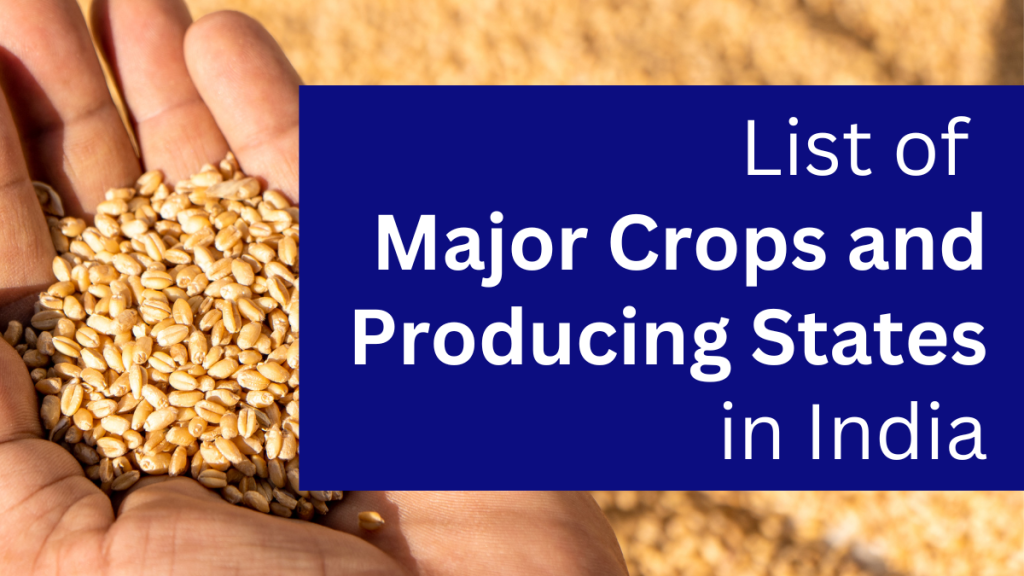India, as a predominantly agrarian economy, is very rich in diversity and has a list of major crops grown in the various climatic and geographical regions of the country. The agricultural sector is the backbone of the country, which gives livelihood to millions of people and contributes a great amount to the national economy. This diversity in soil types, climatic conditions, and water availability has made India one of the major producers of some major crops in India. From staple food grains to cash crops, each variety plays a crucial role in the country’s food security as well as exportability.
The list of major crops in India have been broadly categorized into food crops and cash crops. Food crops include cereals, pulses, and oilseeds, while cash crops comprise of cotton, sugarcane, tea, coffee, and spices. Another classification is as per the growing season under which crops are divided into kharif crops, rabi crops, and zaid crops. Kharif crops include rice, maize, and cotton, which are sown during the monsoon season, from June to September. Rabi crops include wheat, barley, and mustard, which are grown in the winter season, from October to March. Zaid crops include watermelon and cucumber, which grow well during the summer months between the two major crop seasons.

The states of India specialize in the production of some major crops due to their geographical and climatic advantages. For example, Punjab, Haryana, and Uttar Pradesh are known as the “food bowls of India” because of their high production of wheat and rice. Maharashtra and Uttar Pradesh are the leaders in sugarcane production, while Gujarat dominates in cotton output. Kerala and Karnataka are excellent in the production of spices like pepper and cardamom.
Understanding these classifications and regional specializations gives an insight into the economic significance of Indian agriculture. These crops, besides fulfilling the dietary requirements of the country, help industries, create employment opportunities, and contribute to export earnings, making agriculture the lifeline of India.
Major Crops and Their Types in India
Indian agriculture is deeply interlinked with the economy of the country. Due to its varied climatic and geographical conditions, it is a remarkable example of diversity. Indian crops are divided into four broad categories, namely kharif crops, rabi crops, Zaid crops, and cash crops. All of these contribute significantly to food security, industries, and exports. Thus, it is seen that agriculture has played an important role in the growth and development of India. Let’s take a deeper look at the crops in India below:
- Food Crops: Food crops are the backbone of India’s agriculture, mainly cultivated for domestic consumption. They include cereals like rice, wheat, and maize and pulses like lentils and chickpeas. Oilseeds like mustard and groundnut are also part of this category. They play a vital role in ensuring food security, meeting the nutritional requirements of millions, and supporting rural livelihoods.
- Cash crops: These cash crops are produced largely for industrial use and bring massive revenue to the exports of India. A few prominent examples of these are cotton, sugarcane, tobacco, and jute. Such crops are highly in demand due to a high market price, besides providing employment at an agriculture level as well as the industry sector.
- Horticultural Crops: Horticultural crops refer to fruits, vegetables, and flowers used for both domestic and export markets. Some examples include mangoes, bananas, potatoes, onions, and roses. These crops contribute greatly to improved farm incomes, dietary diversity, and agro-processing industries. India’s climatic diversity and varying temperature conditions offer a favorable climate for the production of diverse horticultural products throughout the year.
- Plantation Crops: This sector further comprises plantation crops that are high-value commercial crops grown on large estates. The plantation crops include tea, coffee, rubber, and spices like cardamom and black pepper. The cultivation of plantation crops requires very heavy investment as well as intensive management. These crops are significant for earning foreign exchange, creating rural employment as well as the agro-based economy in states like Kerala and Tamil Nadu where planting occurs in significant proportions and Assam.
Food Crops in India
Food crops form the backbone of Indian agriculture. Growing food crops makes sure that the country has better food security. Below is a list of major food crops in India, their significance, and the states leading their production:
Rice:
Rice is the major staple food item for a good majority of people in India, mainly in south and east regions. The crop, however, requires vast water supply hence it is generally cultivated in a region which receives ample rainwater. The important rice-producing states are West Bengal, Uttar Pradesh, Punjab, Andhra Pradesh, and Tamil Nadu. The temperature between 20 and 35°C and annual rainfall of more than 100 cm characterizes perfect climatic condition for rice growing which is regarded as typical crop of rainy-fed region.
Wheat:
One of India’s most important food crops is wheat, a staple source of nutrition in northern and central India. Wheat grows best in cool and dry climates with temperatures between 10-15°C at sowing time and between 21-26°C when harvesting. The main producers of wheat are Uttar Pradesh, Punjab, Haryana, Madhya Pradesh, and Rajasthan. Wheat plays an important part in food security and, therefore, is a significant component of India’s agricultural economy and dietary patterns.
Maize:
Maize, the versatile crop, is grown everywhere in the country and is used both as food and fodder and as a raw material for the food processing industry. Moderate rainfall of 50-100 cm and temperatures between 21-27°C support maize growth. Karnataka, Madhya Pradesh, Maharashtra, Rajasthan, and Uttar Pradesh are the major states of maize production. Maize is significant in the country’s agricultural and industrial life due to its adaptation to different climates and usefulness in various sectors.
Pulses:
India is the world’s largest producer and consumer of pulses, which is a vital source of protein for its almost entirely vegetarian population. Cultivated in the semi-arid regions, pulses generally thrive in temperatures between 25-35°C with moderate rainfall conditions. States like Madhya Pradesh, Maharashtra, Rajasthan, Uttar Pradesh, and Karnataka are leaders in producing it. Pulses are critical components of Indian diets and contribute significantly towards their soil fertility through nitrogen fixation.
Major Cash Crops in India
Cash crops are cultivated for commercial purposes and significantly contribute to India’s GDP and exports. Let’s look at some prominent types of crops in India categorized as cash crops:
Sugarcane:
India is the world’s largest sugarcane producer, an essential crop for the sugar and ethanol industries. It flourishes under hot and humid conditions at 21-27°C with rainfall in between 75-150 cm. Important sugarcane-producing states in India include Uttar Pradesh, Maharashtra, Karnataka, Tamil Nadu, and Andhra Pradesh. This crop is a cash crop for farmers and enables mass production of sugar, jaggery, and ethanol.
Cotton:
Cotton is often termed the “white gold” of India, providing raw material to the textile industry and forming the backbone of fabric production in the country. The warm climate with 210 frost-free days and moderate rainfall of 50-100 cm is necessary. Maharashtra, Gujarat, Andhra Pradesh, Telangana, and Madhya Pradesh are the primary cotton-producing states. Economically, cotton has very significant importance as it has a multiplier effect on employment within both the agricultural and textile industries.
Tea:
India is one of the world’s largest tea producers and exporters, famous for its Assam, Darjeeling, and Nilgiri teas. Tea cultivation needs humid climates with well-drained soil and temperatures between 20-30°C. The biggest tea-producing states are Assam, West Bengal, Tamil Nadu, and Kerala. This crop forms a significant part of the economy, providing employment and export earnings while having a cultural importance as the most widely consumed beverage in the country.
Coffee:
India is known for producing high-quality coffee, especially Arabica and Robusta varieties, which are mainly cultivated in Karnataka, Kerala, and Tamil Nadu. The crop thrives well under mild temperatures of 15-28°C with moderate rainfall between 100 and 200 cm. The crop is generally grown in shaded conditions on hilly terrain. Its production significantly contributes to the export earnings of India and is an important part of the agricultural economy of the southern states.
Horticultural Crops in India
India’s horticultural sector is known for its production of fruits, vegetables, and spices, which are essential for domestic consumption and export. Some examples include:
Fruits:
India is the world’s largest fruit producer, supplying both internal and export markets. Among fruits, bananas are most widely grown in Tamil Nadu, Maharashtra, and Gujarat. Mangoes, often referred to as the “king of fruits,” are widely grown in Uttar Pradesh, Andhra Pradesh, and Karnataka. Among the temperate fruits, apples have high production in Jammu & Kashmir, Himachal Pradesh, and Uttarakhand, supporting the economy of these horticulture-based regions.
Vegetables:
Vegetable cultivation is an integral part of the Indian agricultural landscape, which fulfills the dietary needs and supports agro-industries. Potatoes are widely consumed throughout India, mainly cultivated in Uttar Pradesh, West Bengal, and Bihar. Tomatoes, being an integral ingredient in the Indian diet, are mainly cultivated in Andhra Pradesh, Madhya Pradesh, and Karnataka. Onions, as a fundamental item in the kitchen, dominate the cultivation in Maharashtra, Karnataka, and Madhya Pradesh to ensure their availability throughout the year.
Spices
India is known as the “Land of Spices,” and it manufactures varied spices for both local and international markets. Major Chilli-growing states are Andhra Pradesh, Maharashtra, and Karnataka. Turmeric is majorly grown in Telangana, Tamil Nadu, and Karnataka due to its health and culinary benefits. Cardamom is also known as the “Queen of Spices” and flourishes in Kerala, Karnataka, and Tamil Nadu, especially in hills.
Plantation Crops in India
Plantation crops are grown on a large scale and are essential for exports and industrial use. Key examples include:
Rubber:
Rubber is a high-value plantation crop that is used for the manufacture of various industrial and consumer goods, such as tires and footwear. It requires temperatures between 25-35°C and annual rainfall over 200 cm. The leading rubber-producing states are Kerala, Tamil Nadu, and Karnataka. Kerala alone accounts for the major share. Rubber cultivation supports the economy by providing raw materials to many industries and creating employment.
Coconut:
Coconut is known as the “tree of life,” being an important crop of Indian agriculture, contributing to oil, coir, and other products. It loves warm tropical climates with average temperatures ranging from 27-30°C and even well-distributed rainfall throughout the year. Kerala, Tamil Nadu, Karnataka, and Andhra Pradesh lead the production of coconut. Coconut crop is very significant, culturally and economically, particularly for the rural livelihood of the people in southern India.
India is a major producer of oilseeds, which play a vital role in ensuring edible oil availability and supporting agro-industries.
Oilseeds:
- Groundnut: Cultivated primarily in Gujarat, Rajasthan, and Tamil Nadu, groundnut is a key oilseed crop grown in semi-arid regions.
- Mustard: Predominantly grown in Rajasthan, Uttar Pradesh, and Madhya Pradesh, mustard is an essential crop for cooking oil production.
- Soybean: Soybean is grown significantly in Madhya Pradesh, Maharashtra, and Rajasthan and can be used for extraction purposes and animal feed purposes.
These oilseeds give a significant contribution toward Indian self-reliance regarding the production of edible oil and earning sources in rural areas.
Major Crops Grown in India and Agricultural Trends
The agricultural sector of India has seen significant growth in the past decades. It has been facilitated by technological advancement, policy initiative, and improved farming practices. Among these milestones, the most significant is the Green Revolution, which started in the 1960s. Introducing high-yielding varieties of wheat and rice along with the increased use of chemical fertilizers, pesticides, and irrigation drastically enhanced food grain production. This revolution made India step out from the nation of deficit food items and self-sustain in main grains such as wheat and rice. This led towards the greater development in the sectors of agricultural though this brought more problems that included soil loss and lack of water content, but which are solved through some of the healthy practices that were implemented within the farming area.
In recent years, horticultural growth has been a hot trend, with India emerging as a leading producer and exporter of fruits, vegetables, and spices. States like Uttar Pradesh, Maharashtra, and Andhra Pradesh have witnessed increased cultivation of crops such as mangoes, bananas, tomatoes, and chillies due to favorable climatic conditions and improved agricultural techniques. Organic farming also has witnessed growth, as home and world demand for chemical-free produce rises. Farmers are changing their mindset to organic farming and selling products to health-conscious customers, boosting organic exports and income from agricultural activities in the country. This is another step in the direction of more eco-friendly and less harmful means of farming according to worldwide trends.
Summing Up
The major crops in India, therefore, depict rich diversification, which can meet domestic requirements and contribute to global markets for export. From essential food crops such as rice and wheat, high-value cash crops include sugarcane and cotton, where agriculture has remained one of the pillars of the Indian economy, giving people the livelihood of millions. Understanding the crop types and their geographical distribution gives further insights into the strengths and weaknesses of Indian agriculture. Further, in this direction, by enhancing continuous investment in innovation and sustainability, India can consolidate its strong position as a world agricultural power.
ixamBee specializes in providing expert guidance and resources for banking exams 2024, ensuring that you are well-prepared for the Upcoming Bank Exams like RBI Grade B, NABARD Grade B, IBPS SO, and more. Our courses align with the bank exam calendar 2024, covering all the essential topics. With a focus on the upcoming bank jobs, our Previous Year Papers, BeePedia, SSC CGL, SSC CHSL, SSC MTS and other Mock Tests are designed to help you excel in upcoming banking exams.
Also Read:
The Complete Guide to Current Affairs Preparation for Banking Exams
National Symbols of India 2024: Learn Their Meaning and Significance
List of Wildlife Sanctuaries in India: Discover Nature’s Hidden Gems














